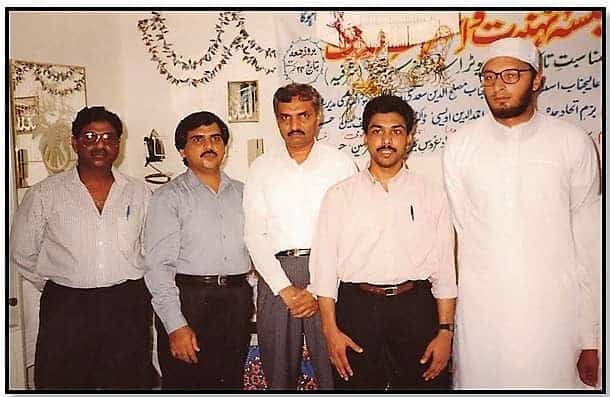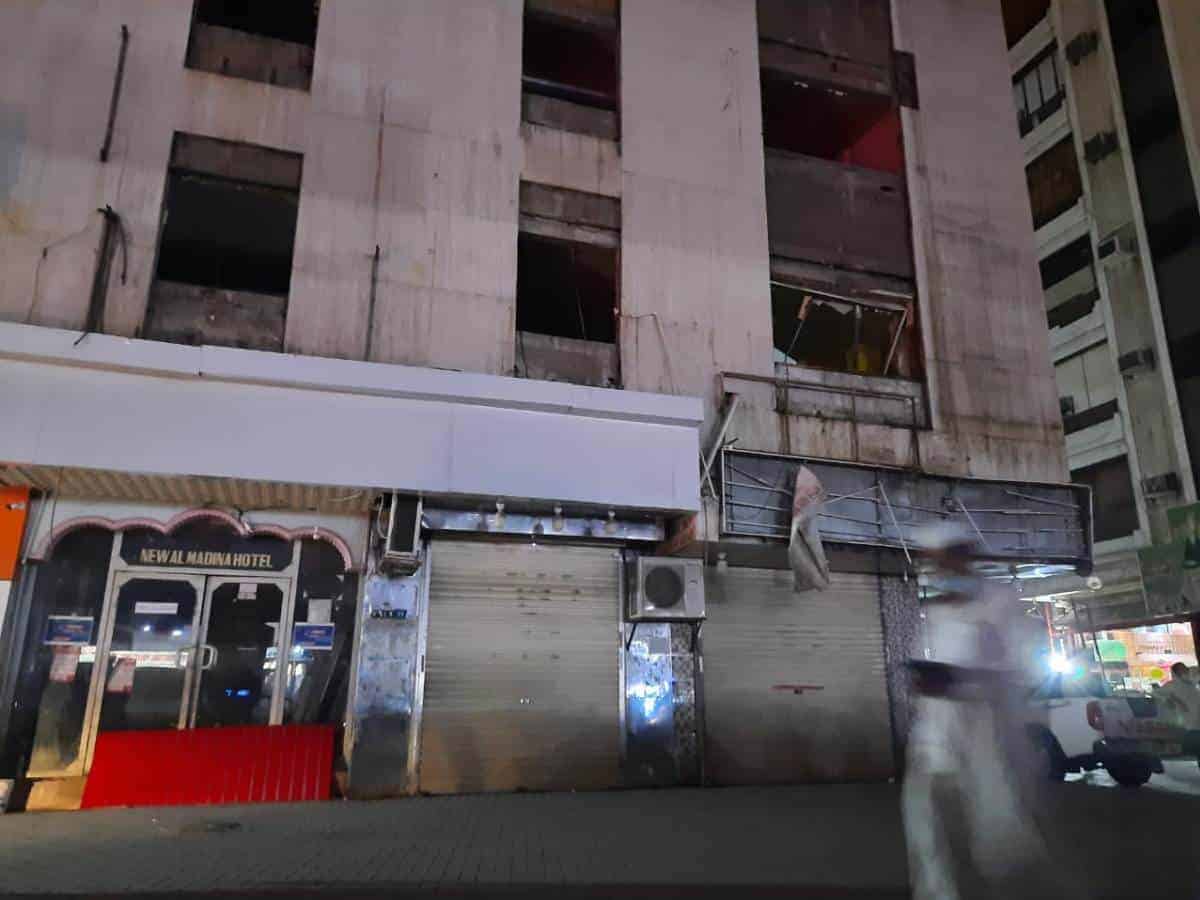By Irfan Mohammed
Jeddah: Once a bustling market for ethnic Indian community in the heart of port city Jeddah, Sharafiah has become a deserted place now. The narrow lanes full of pan chewing crowds become empty. Only municipality workers seen by removing boards and supervising the evacuation of shops in an area where the almost half century old Sharafia market thrived till a few weeks ago.
Sharafia is better known among Hyderabadis for the best tea and paan, both essential part of many Hyderabadis.
‘Oh Khaike Paan Banaraswala’ is how Amitabh Bacchan describes about Paan in the blockbuster DON. Hyderabadis whether at home or abroad paan remains ‘shaan’.
A first Hyderabadi Paan shop cum tea stall known as Boofia was opened in Sharafiyah area in the same year of release of movie DON in 1978 to cater long lasting demand of Hyderabadis in the city. Nayeem, popularly known as Tie Nayeem, had opened that shop.
The cafeteria, though ownership changed, is still frequented by all Hyderabadi expatriates whether professor or labourer for favourite paan and chai. Several other such Hyderabadi cafes came up later, but Nayeem was the maiden one not only in that neighbourhood but in the entire city.
A Hyderabadi gathering or gossip is incomplete without Paan and Chai even abroad. Cafeterias that sell Paan in concealment in tea shops in gulf countries. The sale of paan with traditional ingredients is prohibited here. However, betel leaves are imported from Bangladesh along with other vegetables.








Since the opening of Nayeem Paanshop, Sharafia become point of meeting for most of Bachelors Hyderabadis in the city, even people from far-flung away places such as Taif, Jizan and Madinah also making point to visit it on weekends not merely “Deccani Chai, Paan and Hyderabadi Baata” but to alleviate homesickness.
After Nayeem Paanshop, a renovated Shalimar Building in the heart of Sharafiyah maintained by Hasan Basalamah, Yemeni descendant Hyderabadi expatriate and a friend of the Bombay’s Haji Mastan, added glory. It changed the landscape of the area. The first restaurant of Hyderabadi delicious food known as Shalimar Hotel was established, the space in upper floors were rented out to bachelors and several small shops on ground floor, all selling ethnic Deccani items starting from audio cassettes to mango pickles, fresh meat thrived.
There were no Hyderabadis nor any gathering in the area till 1980s, says Mohammed Abdul Lateef, a longtime Hyderabadi living in Jeddah from 1966.
After working in some reputed firms, Lateef now working in a Paan shop that is adjacent to Nayeem Paan Shop.
He said that majority of Hyderabadis prefer to chew Baba 120 Zarda Pan.
Commenting on average expatriate life then and now, Lateef commented that “Everything has changed”.
When computerization started in the 1980s, Bazm-e -Ettehad, had started to impart the training of MS office and Lotus, some database software to boost prospects of employment to job seeking Hyderabadi youth in the same building. A staunch Majlis supporter Syed Ali Mahmoud, affectionately called by many as Doctor Saab and some even as Daddy, was instrumental in the training that not only helped to be employed for newcomers but also helped many existing employees to retain their jobs by learning computers on 8-inch floppy disks in those days.
“Although we commenced training from 1986 in the Jamia area but opened the training centre in Shalimar building in 1990 that was functional until 2000”, said Syed Ali Mahmoud. He added that the center was closed only after a fire mishap in the building in the year 2000.
“When we set up Air Wings in 1984 in the area it was first travel agency by Hyderabadis not only in Sharafiah but in the city”, said Khaja Muzafferuddin, manager of Air Wings, the only oldest business entity of Hyderabadi that still doing business in the area.
Recalling those old days, Muzafferuddin said that it was Nayeem who turned this place into a hub of Hyderabadis in the 1980s.
“Before 1978, there was no visible presence of Hyderabadis in Sharafiah”, said Mohammed Arif Qureshi, a veteran Hyderabadi cultural activist, living in the city for nearly 50 years.
The Video Ashra, once known for renting video (VHS) cassettes of Bollywood movies, was adjacent to the Shalimar Building. This was the only place that could provide entertainment to Indians when there were no satellite TVs nor internet.
The vegetable market, dominated by Bangladeshis, was the main part of the area. Almost all Indian families irrespective of their ethnic background were visiting the vegetable market for fresh produce shopping with a reasonable price.
The garment, footwear and general stories owned by Malayalis where Hyderabadis engaged in bargaining of price.
The call cabin belongs to the Ministry of communication and posts at that time next to King Fahad Street was one of the four places for public call offices where long queues of expatriates waiting for their turn to call home was common in those days.
Incidentally, Sharafiah was the nerve centre of Hundi Phone that provided the first 60 minute and later reduced to 30 then 20-minute calls for a fixed amount.
Asian Clinic by Dr. Hamed Abdul Quader, opposite to Arab National Bank building, was first clinic by a Hyderabadi physician in the area. With Badaruddin Polyclinic in the same vicinity has begun opening of many other affordable health care facilities and all are managed by Malayalis.
Some Hyderabadis were prompt and punctual to gather in the evening, A Hyderabadi whose name withheld, hailing from Qilwat in the old city, has been visiting the place for nearly 35 years on a regular basis.
He kept a vehicle to reserve the place on the busiest roadside to only sit in the evening hours along with other friends over a sharing cup of tea.
Rough and haphazard parking wherever space is available creates chaos not only making navigation of cars difficult but hindering pedestrian movement in the area.
The predate buildings with chipped paint and exposed brick stood next to walls yet Sharafia became synonymous with the average Hyderabadi bachelor in Jeddah. Many prefer to live in dilapidated buildings that lack facilities including shortage of water in narrow lanes of the area, yet they are not ready to give up and move to other places.
The ongoing anti-encroachment operation in the city entered its crucial phase as municipal authorities demolishing many of the buildings across the city especially in central and southern parts of the city. Jeddah Municipality has identified some 6000 buildings in different parts of the city in general, and southern parts in particular. A specialised company was awarded the contract for demolition of such buildings.
Many of the buildings were built contrary to norms and pose threat to public safety, also this part of the city is known for overcrowding. The ongoing anti-encroachment operation in the city entered its crucial phase as municipal authorities demolishing many of the dilapidated buildings across the city especially in central and southern parts of the city. It also emphasises upon renovation of buildings including façade of commercial spaces. The authorities also made it mandatory to change façade of shop with over a dozen of specifications for billboards, name size boards, front transparent glass doors, front set back space etc.
The fast-paced implementation of renovation rules is giving many business houses in the area a tough time, according to some Hyderabadis in the area.
Sharafia, was the heart of the city once just walkable distance from the airport, which was inaugurated in 1952; also close to Indian embassy then, not the consulate, in Baghdadia. The place is still dominated by Malayalis, hailing from Malbar region of Kerala, for nearly half a century. In fact, the only mosque where sermon in Malayalam language can be delivered is situated in the locality.

